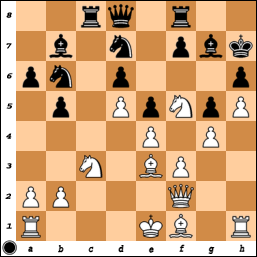Over the last two weeks, the youngest elite of the chess world gathered together in Brazil, to dispute the World Youth Chess Championship in the categories under 8, under 10, and under 12. Over the last several years, the state of Minnesota has made substantial progress, when it comes to organizing regular tournaments, and providing some of the opportunities that young talented players need in order to improve past amateur level. Three of our young players attended this event: Alice Li in girls under 8, her brother Linden Li competed in Boys under 12, and Nastassja Matus competed in girls under 12.
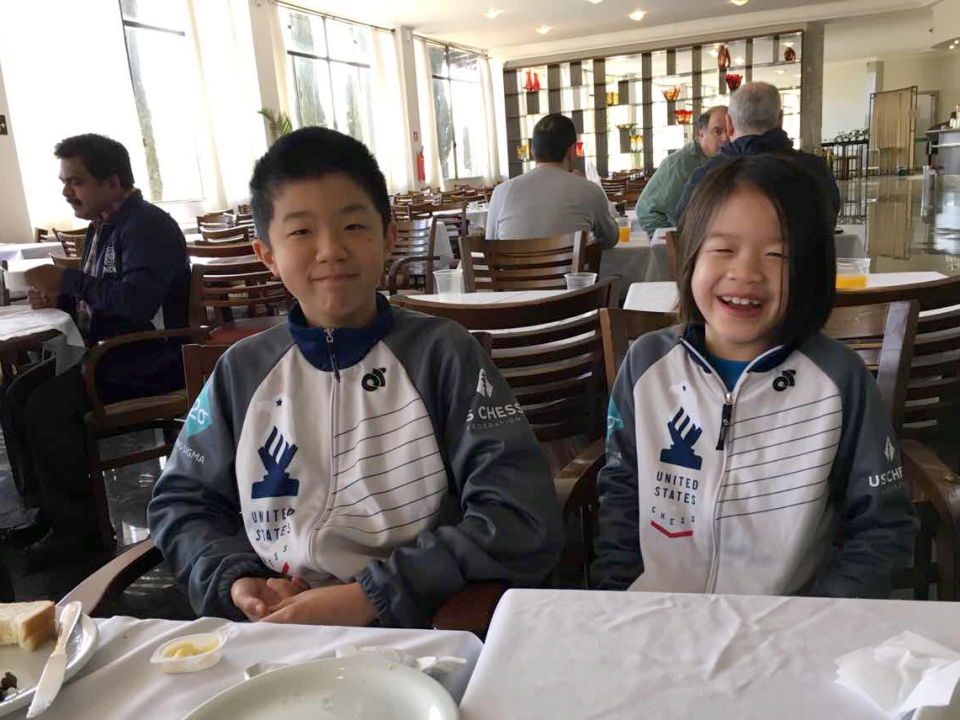
For Alice and Linden, this was their first opportunity to compete in an event of this caliber, and they did so in great form. Alice managed to tie for 3rd place with 8/11, though she finished 5th on tiebreaks. She finished higher than all other American players in her category, thus confirming she is in fact the strongest American girl in her age group. Her brother Linden had a strong first performance with 6.0/11. Both of their performances are very promising, considering that these siblings played their first chess competition only 1 year ago.
Nastassja Matus has already accumulated plenty of World Championship experience over the years. This is her fifth event, but this year her chances were much higher, as she has been accumulating a series of excellent results over the last year. Nastassja obtained the Woman Fide Master title last year, after winning the Pan American under 12 (at age 11), and this year, she obtained 4th place at the Pan American under 18, quite a convincing display of her ability. She also managed to win the Susan Polgar Girls Invitational Event, overcoming the nation’s top high school and middle school female players, again, in a very convincing fashion.
Nastassja’s results did not disappoint. She was able to defeat former World Champion Rakshitta Ravi (Greece 2015, under-10) among many other strong players. Toward the end of the tournament, the tournament was a two-horse race between Nastassja and Divya Deshmuk, the eventual winner. They were both winning their games, but unfortunately, Divya Deshmuk emerged as the sole winner in the final rounds. For my taste, this was perhaps a combination of experience, and maybe even a little bit of chess-luck (more on this later). Now, let’s see one interesting game from each player:
Linden’s 9th round victory
1. d4 Nf6 2. c4 e6 3. g3 d5 4. Nf3 c6 5. Bg2 Bd6 6. Qc2 Nbd7 7. O-O O-O 8. Nbd2
White is getting ready to play e2-e4, going into a favorable CaroKann type
structure. Now 8…e5 It seems that Black may need to play this move sooner or later
in order to prevent White from gaining a strong control of the center after
e2-e4.

If Black had played 8… Re8 then after 9. b3 Qe7 10. Bb2 e5 11. cxd5 cxd5 12.
dxe5 Nxe5 the position is similar to the game.
The point is that, after 8…Re8 9. e4?! is met by Nxe4! 10. Nxe4 dxe4 11. Qxe4 e5! =
and Black achieves the standard …e6-e5 break of the Caro Kann pawn structure,
without losing any material in the process. White immediately loses his
central dominance, and the game is even.
9. cxd5 cxd5
Black could avoid the creation of an isolani by playing 9… Nxd5?! but then after 10.
Nc4 Qe7 11. Nxd6 Qxd6 12. e4 Nb4 13. Qc3 White’s much better. We will end
up playing a 2-4 vs. 3-3 pawn structure, in which White has the pair of
bishops and better piece coordination
10. dxe5 Nxe5 We have reached an Isolani pawn structure, chapter #1 in my book. In many cases Black could like to play for a kingside attack, but this is unlikely to happen here, given the fianchetto. White’s position seems to be somewhat preferable, but any
advantage is minimal at the moment, since Black still has his dark-squared
bishop, a key player given his isolani is on a light-square (d5)
11. e3?! This move is rather imprecise for two reasons:
- White could have developed his bishop via g5, or e3-d4, but now this is impossible.
- This move is unnecessary, does not really add anything, but it does waste a tempo.
Linden should have continued with 11. Nxe5! Bxe5 12. Nf3 Bd6 13.Rd1 with a pleasant advantage. The d5-pawn is well blocked, and Black does not seem to have any obvious sources of counterplay. Still, Black would have a solid position; this position could have led to a long fight.
We continue with the game:
11…Nxf3+
To illustrate White’s imprecision, Black could have continued with
11… Qe7 since now 12. Nxe5 Qxe5 13. Nf3 Qh5 and the queen on h5 is far
more active than on d8, so this position is much more promising for Black than
the position after 11.Nxe5
12. Nxf3 Be6 13. b3 Rc8 14. Qd3 Qe7 15. Bb2
White has secured a stable advantage, the d5-pawn is well blocked, and now he
can improve his pieces gradually

15…h6 16. a4 Rfd8 17. Nd4 a6 18. Rfd1 Rd7?
Black should have probably continued with 18… Be5 to prevent White from
placing a knight on f5 too easily.

19. Nf5! Qd8 (In case of19… Bxf5 20. Qxf5 Black is losing material by force, due to the pressure on f6 and d5, for example: 20… Rcd8 21. Bxf6 Qxf6 22. Qxf6 gxf6 23. Rxd5 Be5 24. Rxd7 Rxd7 25. Rc1 and the resulting ending is nearly winning for White in
spite of the opposite colored bishops
20. Bh3!? Linden, just like most typical young talents, is constantly on the lookout for tactical opportunities, and this game is no exception. Perhaps he missed a good positional idea in this game, but his calculation ability will get him far.
He could have secured a substantial advantage after 20. Nxd6 Rxd6 21. Rac1,
since now Black does not have his dark-squared bishop. This piece is very
important because the isolani is on light-squares. Now White can easily move
through dark-squares, especially the d4-square, giving him a very good control
of the game. For reference, you can see the game Vitiugov-Bologan (1-0), in
page 28 of the first chapter of Chess Structures.
20… Rb8? Black has missed the threat posed by 20.Bh3, and he will suffer the consequences. Black should have played 20… Bf8 . Now the game continued with
21. Nxh6! gxh6 22. Bxe6 fxe6 23. Qg6+ Rg7 24. Qxf6
White has a clean pawn up, but now Black has some counterplay
that needs to be neutralized

24…Qxf6 25. Bxf6 Rf7 26. Bd4 Rc8 27. Rac1 Rfc7 28. Rxc7 Rxc7 29.
Rd3 Bb4 30. Be5 Rc1+ 31. Kg2 Rc2?! More stubborn would have been 31… Kf7
32. Rd4! Bc5? this mistake allows White to gain a decisive advantage:
33.Rg4+ Kf7 34. Rg7+ Ke8 35. Rc7! now Black’s forces are paralyzed, and
White can win more material while Black must deal with the pin along the c-file. 35…a5 36. Bf4 b6 37. Bxh6 Rb2 38. Bg7 Rxb3 39. h4 and the h-pawn will decide
the game 39…Be7 40. h5 Kf7 41. h6 Black resigns. Overall, a very convincing
game, from a young talent, who has only practiced chess seriously for a little
over a year. I hope to see much more from this player in the coming months and
years. 1-0
Alice’s 9th round victory
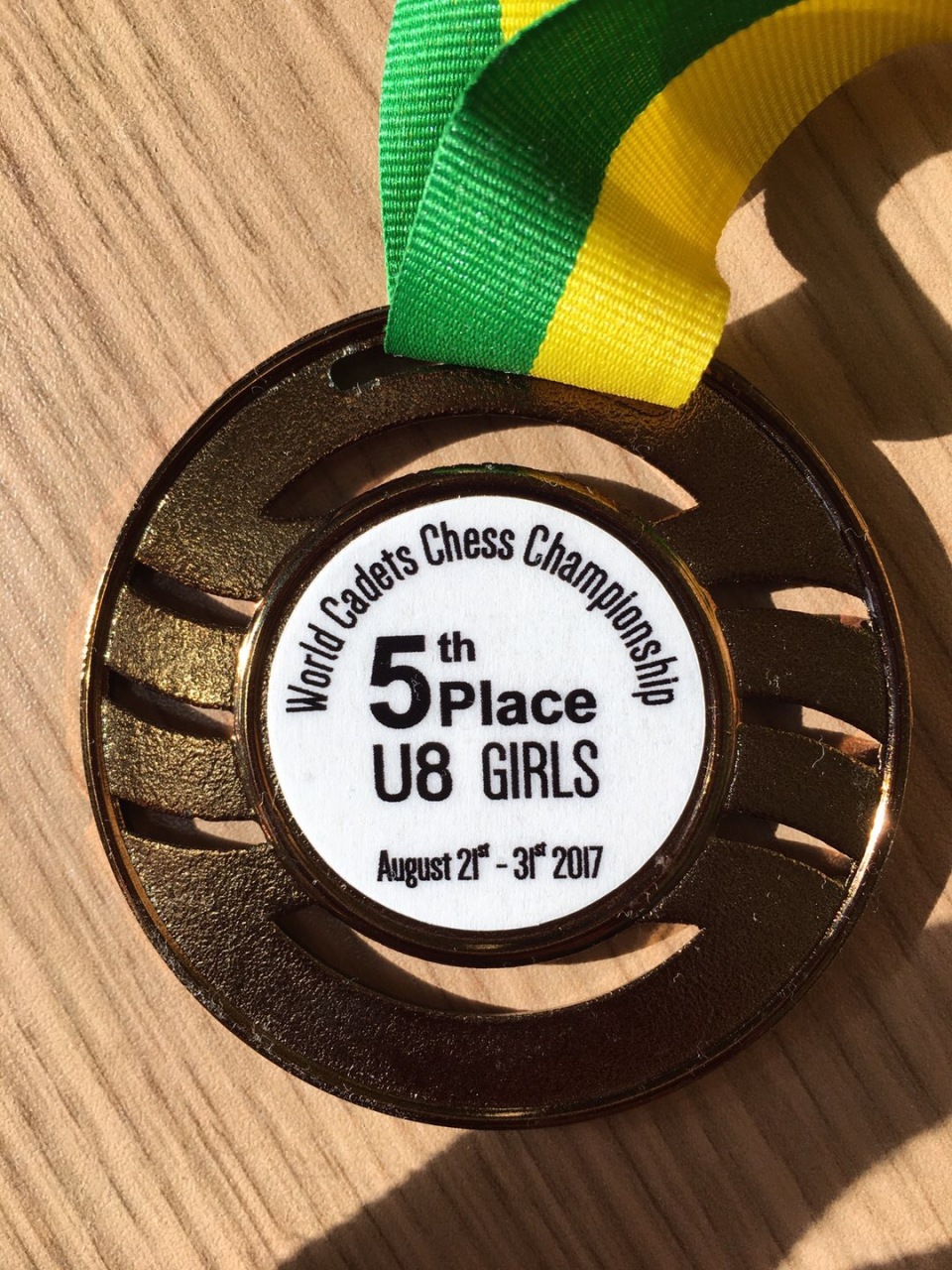
1. d4 d5 2. c4 c6 3. Nf3 Nf6 4. g3!? a relatively unusual move order; Alice
aims to play Catalan style, in spite of Black choosing the Slav 4…Bf5 5. Bg2
Bxb1?! Black hopes to win a pawn, but in the process falls behind in
development.
Black could have secured a solid position after 5… e6 6. Nc3 Nbd7 7. O-O h6 and now White’s light-squared bishop is not particularly impressive against Black’s c6-d5-e6 center, but more importantly, the bishop on f5 is very well placed, compared to the bishop on c8, which is typical of the Catalan.
6. Rxb1 Qa5+ 7. Bd2 Qxa2 8. cxd5 Qxd5 9. O-O
For the cost of one pawn, Alice now has the pair of bishops, initiative, and will gain control of the center after an eventual e2-e4.

9…Qd8 10. Qb3 Qb6 11. Qc4! of course, trading queens is undesirable 11…e6 12. Ne5 Be7 13. Bh3!? an interesting idea, preventing Black from castling, hence keeping the king in the center, where it will be in constant danger 13… Nbd7 the point of Alice’s
last move is that if Black tried to castle with 13… O-O? then after 14. Bxe6! fxe6 15. Qxe6+ Kh8 16. Qxe7, and White is two pawns up.
14. Be3 this move prevents Black from taking on e5, but at the same time, blocks the
desirable e2-e4 move 14…Nd5 15. Nxd7 Kxd7 16. Bd2!
Alice takes a step in the right direction. Now e2-e4 and d4-d5 are coming
16…Rad8 17. e4 Nc7 18. d5!
Alice displays an excellent understanding of the game, by opening the center when
her opponent’s king is unsafe, and at the same time, taking advantage of her
bishop pair
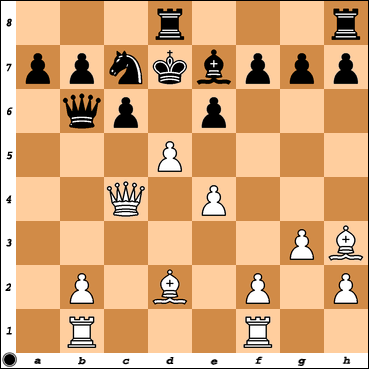
18…Qc5 19. Qb3! Again, White does not wish to trade queens, but at the same time, Alice keeps the pressure on the e6-pawn 19… b6 20. Bf4 Bd6 21. dxc6+ Qxc6? {only makes things worse, escaping with the king was necessary. Black should have played 21… Kc8! in order to secure a safe place for his king
22. Rfd1 22… Ke7 23. Rbc1 Qb7 (Black’s last chance was playing 23… Bc5) 24. Bxd6+ Rxd6 25. Qb4 creates a decisive pin, and wins the game convincingly.
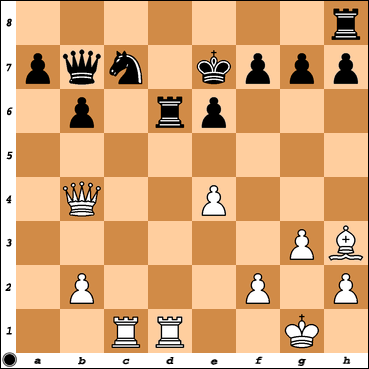
25…Rhd8 26. Rxd6 Rxd6 27. e5 a5 28. Qxd6+ Ke8 29. Rxc7 Qa8 30. Qe7# Quite a brilliant win for someone who has yet to turn 8. 1-0
Nastassja’s 3rd round win

1. d4 Nf6 2. c4 e6 3. g3 Bb4+ 4. Bd2 Qe7 5. Nf3 Nc6 6. Nc3 d6 7. Bg2 Bxc3 8.
Bxc3 Ne4 9. Rc1 O-O 10. d5 Nxc3 11. Rxc3 Nb8 12. dxe6 fxe6 13. O-O Nd7 14. Qc2
e5
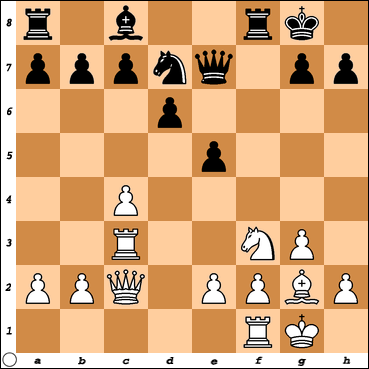
This is what chess progress has come to in recent years. Here we have two
(admittedly very strong) 12-year old girls, playing 15 moves straight from the
book. White enjoys a very slight advantage because of his development lead,
but of course, a huge level of precision is required if one wants to preserve
this advantage into the middlegame.
Now White played 15. Nd2! clearing the h1-a8 diagonal for the bishop (making it hard for Black’s bishop to develop), and at the same time, preparing for a potential c4-c5, after preparing it with either b2-b4 or Ne4} 15…Nf6 16. Ne4! an excellent move, trading Black’s only defender of the d5-square, and therefore preparing the c4-c5 break in the next move.
16… Kh8?! this is a relatively subtle imprecision. Most players would not have known how to capitalize on this mistake, but Nastassja does not waste time: 17. Nxf6! White has a clear plan, and trading that knight is a part of it, c4-c5 is now imminent 17… Qxf6 (in case of 17… Rxf6, then 18. c5!)
18. Rf3 (White could have also continued with the direct 18. c5)
18… Qe7 19. Rxf8+ Qxf8 20. Rd1 preparing c4-c5

20… Bf5 21. Qd2 Rb8 22. Qa5! Nastassja does not miss one opportunity, and
she will now be a pawn up even though Black did not make any serious mistake
yet 22… Qc8 23. Qxa7 Ra8 24. Qxb7 Qxb7 25. Bxb7 Rxa2 (in case of 25… Rb8?! 26. Bd5 Rxb2 27. Ra1! and now White’s a-pawn is very threatening. 26. Rd2 Ra7 27. Bd5

White has a clean pawn up, with no compensation, and the rest was relatively easy
27…Bh3 28. f3 h5 29. Be4 heading toward g6, in order to capture the h5-pawn 29… Kg8 30. Bg6 Kf8 31. Bxh5 Ra1+ 32. Kf2 Rf1+ 33. Ke3 Bf5 34. Bg4 Bg6 35. Be6 Ke7 36. Bd5 Kd7 37. c5! Rh1 38. cxd6 cxd6 39. h4 Rc1 40. g4 Rc5 41. Be4 Bf7 42. Rc2 Ra5 43. Bf5+ Ke7 44.Kf2 g6 45. Rc7+ Ke8 46. Bd3 d5 47. b4 now the b-pawn will easily decide the game Ra8 48. Bb5+ Kf8 49. Bc6 Rb8 50. b5 Be6 51. Ra7 d4 52. Ra8 Rxa8 53. Bxa8 Ke7 54. Bc6 Bf7 55. b6 Kd6 56. b7 Kc7 57. Ke1 Bc4 58. Be8 Kxb7 59. Bxg6 Kc7 60.h5 Bg8 61. h6 1-0
Black resigns. Overall, a very convincing win for Nastassja. I
was particularly impressed with her solid opening and how quickly she was able
to turn a small opening advantage into an extra pawn, to later convert a
winning ending, without ever giving chances. Nastassja’s ability to convert
good positions showed throughout the entire tournament, as she defeated some
of the strongest girls in the world. This time, she had to settle for a Silver
Medal, not bad, but I certainly see a Gold Medal in her future. 1-0










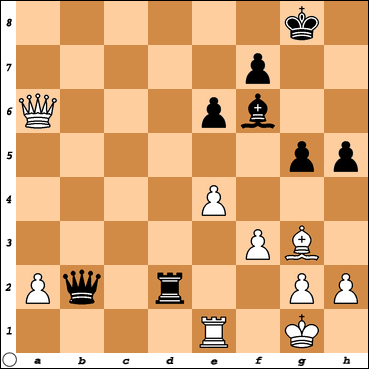

























 Black has great prospects of kingside play after …Kg7 and the …h7-h5 break. Instead Black played 27…Bg5?, and after 28.f4! exf4 29.Bxf4 we obtained the position:
Black has great prospects of kingside play after …Kg7 and the …h7-h5 break. Instead Black played 27…Bg5?, and after 28.f4! exf4 29.Bxf4 we obtained the position:













